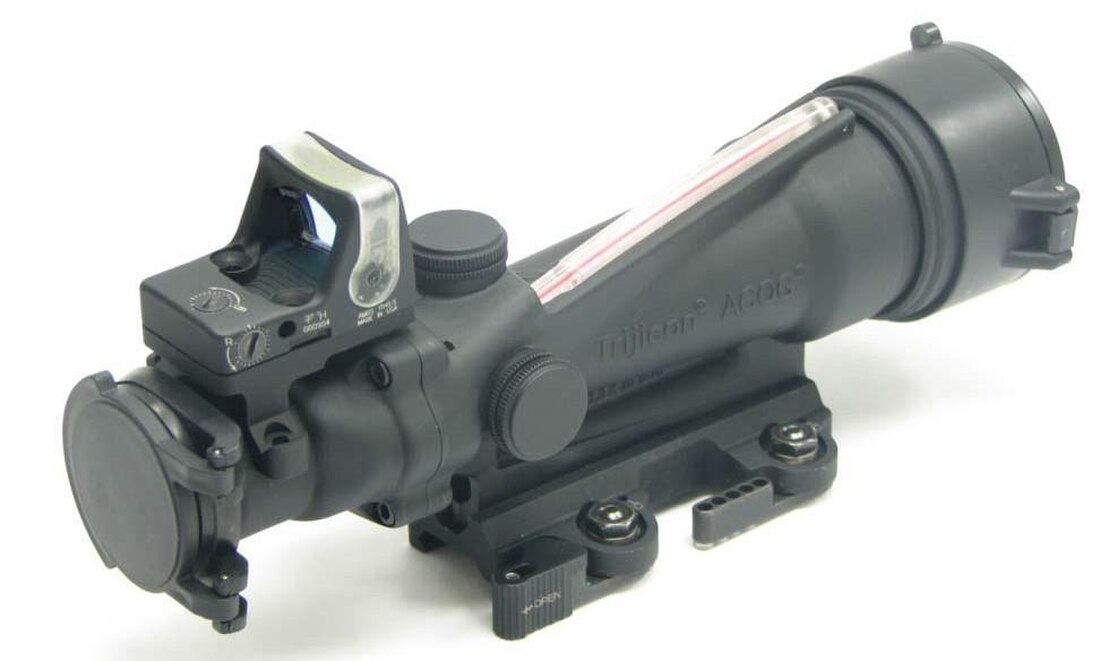Prism sight
Type of telescopic sight From Wikipedia, the free encyclopedia
A prism sight or prismatic sight, sometimes also called prism scope or prismatic scope, is a type of telescopic sight which uses a reflective prism for its image-erecting system, instead of the series of relay lenses found in traditional telescopic sights. The use of prisms makes it possible to construct a shorter and lighter sight, or with an offset between the eyepiece and objective axes, although restricting the achievable range of magnification.

Description
Summarize
Perspective
Prism sights are a type of telescopic sight with similar features and limitations. Most prism sights use roof prisms commonly seen in compact binoculars and spotting scopes. The reticle is etched onto one of the internal reflective surface of the prism, making it easy to illuminate the reticle from the back of the prism even when active illumination is turned off.
Magnification


Prism sights often have fixed low-power magnification such as 1× (parity magnification or "non-magnifying"), 2×, 3× or 4x magnifications, sometimes 5× or more. Although the low magnification range means not the most visual details when aiming and observing targets, it allows larger fields of view, making them best suited for shooting at short or medium engagement distances.
There are prism sight designs with variable magnification, such as the ELCAN Specter DR/TR series.
Reticle
Like telescopic sights, prism sights have an etched reticle which makes them suitable for shooters with astigmatism, unlike reflex sights or holographic sights which may be near useless for these shooters depending on the severity of the astigmatism. The reticle is often illuminated, and is visible without illumination. Etched reticles make for the possibility to have more advanced reticles. Some prism sights are available with ballistic reticles which can be used for holdover for shooting at varying distances without turning the adjustment knobs.
Diopter
Prism sights usually have eyepieces with adjustable diopters so that the image can be adjusted for nearsightedness or farsightedness.
Parallax
Prism sights have a somewhat larger parallax error than red dot sights. Usually, they do not have an adjustable parallax like some telescopic sights.[1]
Eye relief
Another disadvantage is eye distance.[2] Like telescopic sights, the eye must be within a certain distance from the scope.
History
Summarize
Perspective

Prisms have been used in binoculars since the 1890s.[3] During World War I, the US Army chose to equip the M1903 Springfield repeating rifle for the sniper rifle role by mounting a sight similar to half a binocular, a prismatic sight developed by the Warner & Swasey Company.[4] It was a short and compact sight, and the prisms allowed the objective to be angled to the side so that the 1903 rifle could be loaded with a clip from above. It was still possible to use the iron sights with the scope mounted.[4]
The M1908 version of the scope had 6-times magnification, while the later M1913 version had slightly less magnification at 5.2×. The background for choosing a lower magnification was a larger field of view and improved light transmission.[4] The sight was constructed of steel and brass, was painted black inside for optical performance, and had a relatively high mass of 1,020 g (36 oz).[4] The eye relief was only 38 mm (1.5 in), so the sight was equipped with a rubber eyepiece shield to prevent the scope from hitting the face during recoil. The reticle was a thin crosshair, as was common for this time period.[4]
These sights were fitted to the Hotchkiss M1909 Benét–Mercié machine gun.[5] Canadian Forces ordered 500 samples of the 5.2× variant.[6] Moisture on the inside of the lenses was one of several problems in the field,[6] and the scope was known to loosen.[7][8] In total, approximately 8,000 units of these prismatic sights were produced. The scope sight had the greatest magnification of the First World War, but in return only had a 4.5 degree field of view.[6]
A well-known later example is the fixed-magnification Trijicon ACOG which has been used in combat by the US Marine Corps, US Army and USSOCOM.[9]
In the 2010s, several manufacturers including Trijicon, and Vortex began offering prism sights on the consumer market.
In October 2019, the Chinese QBZ-191 automatic rifle was revealed at the 70th Anniversary National Day military parade. It has a 3× daylight prismatic sight called QMK152 and QMK-171A.
See also
- Red dot sight, usually referring to a reflex sight with a red dot, but sometimes a holographic sight or prism sight
- Low-power variable optic, a variable-zoom telescopic sight with magnification range from 1x to no more than 10x
References
Wikiwand - on
Seamless Wikipedia browsing. On steroids.
